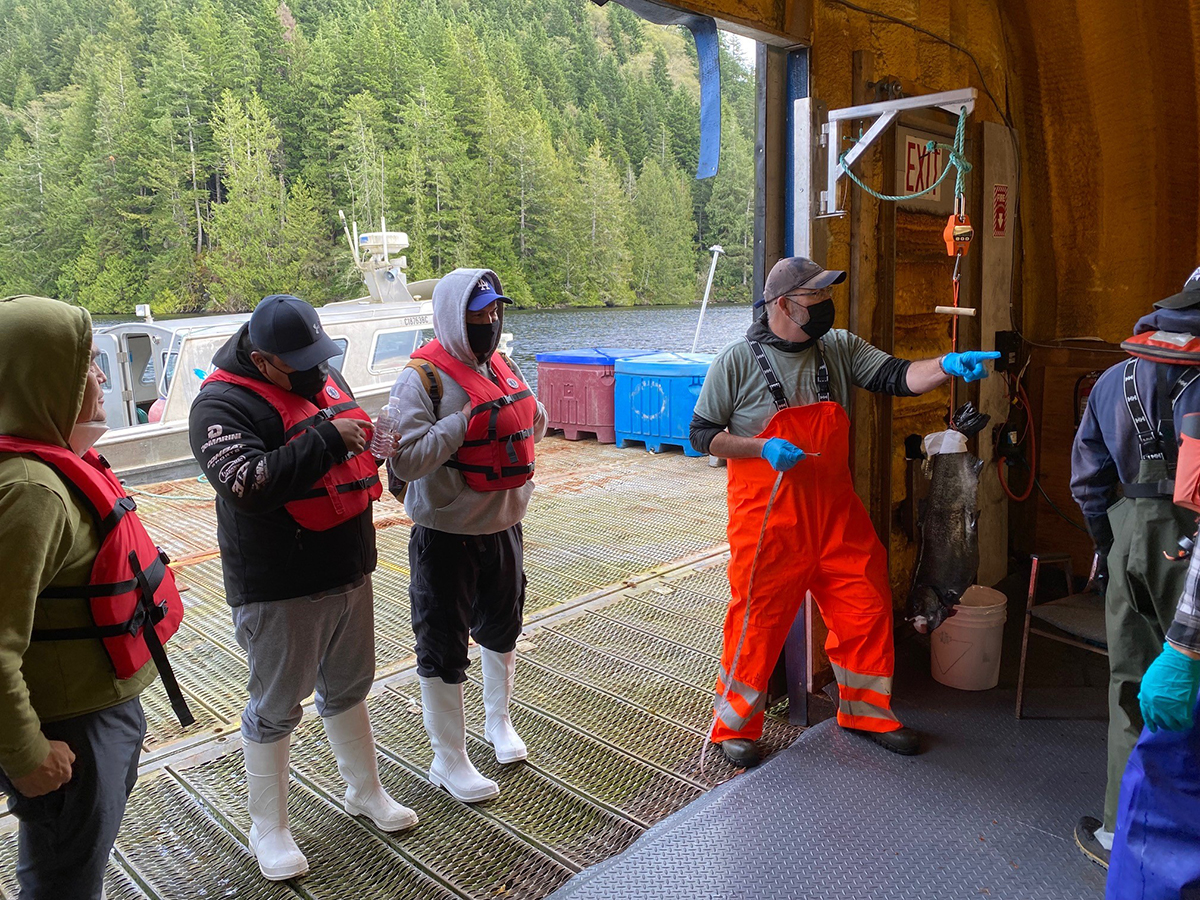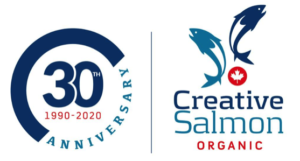
Tla-o-qui-aht Hereditary Chief Simon Tom along with Syphton Jackson and Desmond Tom Jr from the Tla-o-qui-aht hatchery visited the Creative sea sites and Creative’s Sea Spring Hatchery near Duncan in October 2021 to observe spawning activities. Peter Griffiths, Creative’s Hatchery Manager pictured on the far right, explained what happens on the seasites to strip eggs from the females.
Creative Salmon operates in the traditional territory of the Tla‑o‑qui‑aht First Nation and their participation and inclusion are essential to Creative’s success.
“Creative values its long-term and ongoing relationship with Tla‑o‑qui‑aht. It’s been described to me that we are walking with the Nation and Creative knows we need to continue doing this,” says Tim Rundle, Creative’s General Manager. “We know we have to be a good and active partner so we can help protect and preserve what is valuable to Tla-o-qui-aht.”
Creative’s promise to Tla-o-qui-aht includes an ongoing Protocol Agreement that underpins Creative’s operations and a new Ambassador Program that gives Tla‑o‑qui‑aht members an opportunity to see first-hand how Creative is meeting its commitments. “Accountability and communication are important to us and Tla‑o‑qui‑aht,” says Tim. “Clearly-defined, agreed-upon expectations and regular feedback make Creative a better neighbour and community member.”
Tla‑o‑qui‑aht Protocol Agreement / Fish Farm Committee
In July 2014, after two decades of relationship building and cooperative effort, Creative finalized a Protocol Agreement with the Tla‑o‑qui‑aht First Nation Hereditary Chiefs. The protocol established guiding principles for its Chinook salmon farming operations within the Haahuulthii (traditional territory) of the Tla‑o‑qui‑aht Hawiih (Chiefs).
“Stewardship of our lands and waters is the responsibility of the Chiefs,” said (the late) Hereditary Chief Bruce Frank in the Fall of 2021. “To Tla-o-qui-aht, it is Hishuk ish ts’awalk meaning everything is one or connected. Business activity in our territory must also respect our values.”
Protocol commitments from Creative include only raising Chinook salmon, not using anti-fouling agents on nets, maintaining low pen densities, no underwater night lighting, and closely monitoring fish health at its sites.
The protocol agreement established a joint company-Nation Fish Farm Committee for exchange of information on subjects such as predator management, benthic (ocean bottom) monitoring, feed content, and fish health.
Bruce says a top priority for Tla-o-qui-aht is ensuring an abundance of wild salmon return for the Nation’s food, social, ceremonial, and commercial needs. “Creative recognizes this priority and helps the effort through the protocol with support for habitat restoration, salmon enhancement, and monitoring programs,” says Bruce.
He notes the relationship between Creative and the Nation has come a long way over the years thanks to communication, relationship building, and the company being willing to answer questions.
“Creative Salmon has been around for more than 30 years. They’ll be around for many more if they keep being inclusive and open, and continue to meet the expectations of our people.”
Tla‑o‑qui‑aht Ambassadors

Tla‑o‑qui‑aht Ambassadors on a recent site tour. Left to right: Creative’s Tim Rundle, Hereditary Chief Simon Tom, Ambassador Terry Crosina, Hereditary Chief Robert Martin, Ambassador Lorena Frank, and Ambassador Joe David.
Involving the Tla‑o‑qui‑aht has been embedded in the Creative approach to farming Chinook since the company was formed in 1990. While Tla‑o‑qui‑aht participation has taken a variety of forms over the years, part of the current model is built on regular contact with the Tla‑o‑qui‑aht Ambassadors.
Lisa Stewart, Creative’s Communications, Human Resources, and Sustainability Officer, says Creative’s goal is to have the Tla‑o‑qui‑aht Ambassadors know they can ask anything. That means taking an active role in helping the Ambassadors understand the in-and-outs of aquaculture and Creative’s special ways of doing things.
“Sustainable, organic-based salmon farming isn’t something a person learns in an afternoon,” says Lisa. “It’s a technical undertaking. The more our Ambassadors know, the more they can contribute and answer questions within their community.”
Ambassadors are invited to regular meetings and information sessions that, over time, combine to tell Creative’s entire story including Creative’s organic certification, egg-to-plate process, and dedication to the environment and fish health.
Where the rubber hits the road, says Ambassador Joe David, are the site visits and excursions when he and his fellow Ambassadors get face-to-face in the field with Creative’s leadership team and crew. “We get to see the facilities, meet the team, witness their work, and compare what they said they’ll do to what they’re actually doing.”
Ambassadors have been invited to Creative’s sites with plans to bring them to the processing plant, hatchery, and partner facilities such as the plant where the feed Creative uses is produced on the Lower Mainland. The COVID-19 pandemic has meant some delays and postponements for the new Ambassador Program, but the energy and commitment are not taking a back seat.
“There is a lot of info and a lot to digest, but I’ve never felt like there’s anything they’re holding back,” says Joe, adding that the meetings and visits provide opportunities for the Ambassadors to discuss any concerns they hear from the larger Tla‑o‑qui‑aht community.
“Whether the feedback is coming from us, our families, our friends or our neighbours, the program is an opportunity for Tla-o-qui-aht voices to be heard.”
For more information on Creative’s commitment to the Tla‑o‑qui‑aht First Nation and environmental accountability, visit: creativesalmon.com/promise

